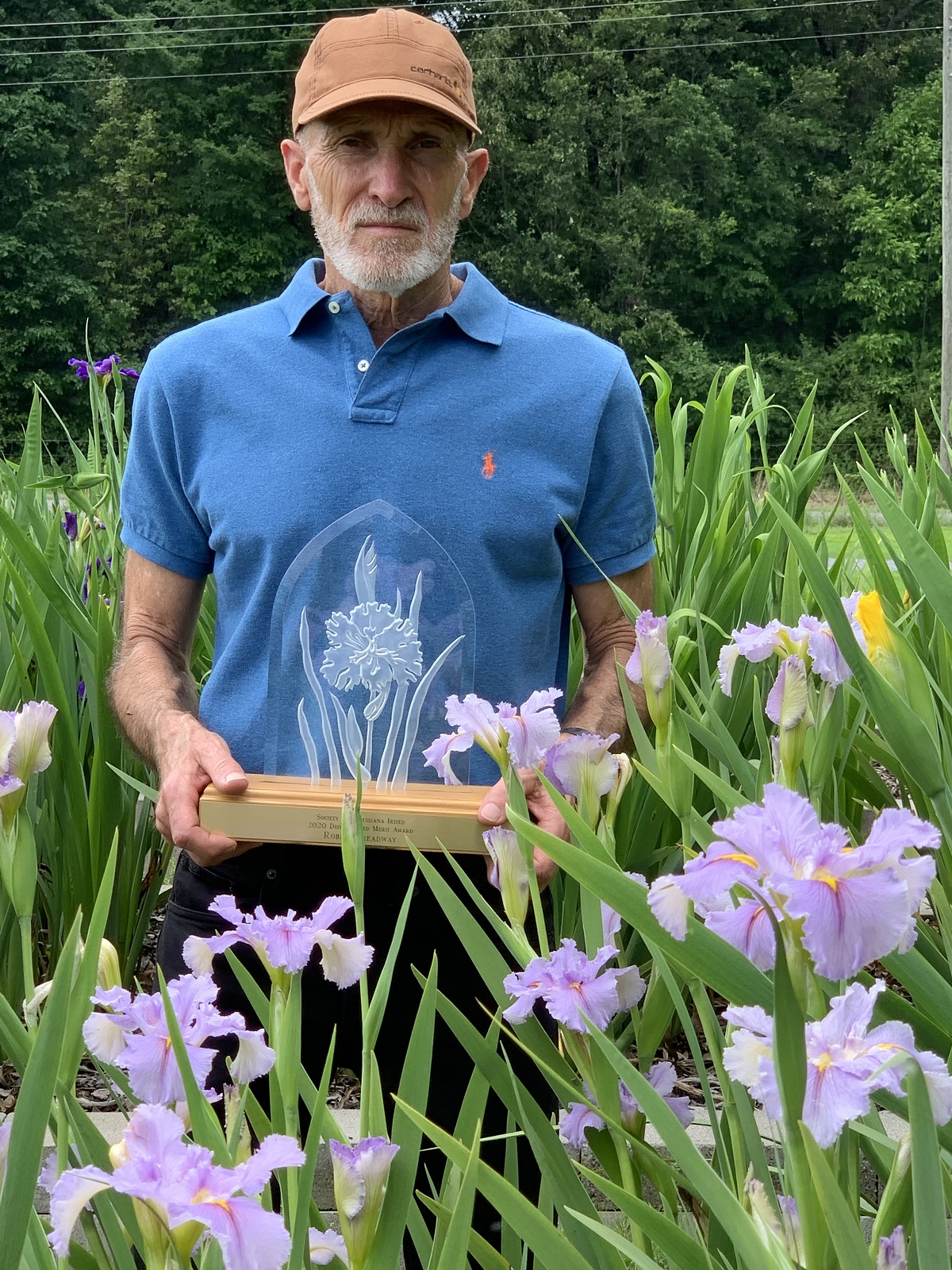by Tom Dillard
I like Louisiana irises, but they are merely one among many different plants I grow in my garden. Of course, there is nothing wrong with a garden composed solely of Louisiana irises, just as some folks could find satisfaction in a garden of cactus, or asters, or, I suppose, daffodils—though in the later example the garden would appear awfully barren for most of the year!
Actually, I grow two gardens—one is filled with flowers, shrubs, trees, ground-covers, statuary, a fish pond resplendent with pink and yellow water lilies. I grow my other garden in my mind, in my imagination. Both of these gardens are real to me. From one I derive the pleasure of working the soil, producing scenes of beauty, cutting flowers for every room of my home.
From the garden of my mind I take equally valuable gifts. I can close my eyes in the middle of January, while sleet lashes the window panes, and see the great swaths of black eyed susans that meandered through my garden last year. Or, I can try out new plants, experiment with new designs, or banish every dandelion from that garden of my imagination!
Often my real garden, situated on a rocky ridge in an old Little Rock suburb, falls far short of measuring up to the garden of my imagination. There’s much too much shade, not nearly enough humus, and I’ve spent far too much money on stone retaining walls and not nearly enough for irrigation. And then there was the problem of sticking in far too many Louisiana irises into every bed and border, even into the vegetable plot.
In recent years I’ve worked steadfastly to get more light. Peat moss purchases have caught the attention of my bookkeeper (my usually tolerant spouse). But, I still find it almost impossible to remove irises from the garden. Spending $350 to have an oak tree removed in order to get an additional shaft of sunlight—I can do that. But remove a clump of Louisiana irises—that is an almost impossible task!
My salvation is that “garden of the imagination.” When I visualize the garden I want—rather than the garden I have—I can do a much better job of selecting plants and designing garden vistas. I can see DIXIE DEB (Chowning, ’51) bringing life and yellow light to an area between a viburnum and a large azalea, a huge clump of species Hosta ventricosa filling up the foreground like a great green comforter. My mind wanders through a gate, and there on the right is a pale pink ‘New Dawn’ climbing rose, its great long arms clothed in pink clouds as they dangle from an arbor. The pink rose rustles in the breeze, petals fluttering down and accumulating around a large clump of LA PEROUSE (Raabe, ’77), the royal blue and pink as compatible as twins.
In recent years, as I’ve tried to bring more structure and design to my garden, I have found that though I grow fewer Louisiana irises, the ones I do grow contribute much more dramatically to the beauty of the place.
Though the details are far from worked out, a few generalizations can be made about using Louisiana irises successfully in a mixed planting. Of paramount importance in situating a clump of Louisiana irises is to provide a background. I make a lot of use of stone walls, dense evergreens like Leyland cypress, and muscadine and other vines. Garden designers often refer to this as “framing the garden scene,” which means providing a uniform backdrop so the flower being emphasized does not disappear into the background clutter.
Assuming one chooses the right site for a clump of Louisiana irises, the second most important consideration is choosing the neighboring plants. Here are a few of my favorite plants to grow with Louisiana irises.
Among the best deciduous shrubs to grow in proximity with Louisianas is the smoke tree (Cotinus coggygria). This shrub, which can be kept to under six feet in height by periodic pruning, sends forth its spring foliage in the deepest sultry purple. Yellow Louisianas, such as the rich golden yellow ROKKI ROCKWELL (Haymon, -92), contrast dramatically with a smoke tree billowing in the background. A less dramatic contrast, but perhaps more pleasing, would be a pale Louisiana, such as BOB WARD (Morgan, ’83), a tall one that has just the right hint of muted red before the flowers fade to a crisp white. A good variety of smoke tree is ‘Royal Purple,’ which holds its purple well into the summer before turning a satisfactory green.
A very different small deciduous shrub is Itea virginica, commonly known as the Virginia sweet spire. Unlike the somber smoke tree, the itea is a brazen show-off. It is covered with 8 inch panicles of creamy white flowers in the Spring just when the Louisiana irises are at their peak. A nice rusty red Louisiana is just the thing to tone down the Ilea, say RHETT (Dunn, ’83) or maybe CHERRY CUP (Morgan, ’89). As an added bonus, the Itea revert back to their exhibitionist nature in the autumn, their leaves turning a dramatic garnet red before dropping away to reveal nice russet stems.
Plants with bold foliage make especially compatible neighbors for Louisiana irises. I’ve already mentioned hostas, which I find especially pleasing with yellow Louisianas. One very odd plant, which is seldom seen in the garden, is a species of black eyed susan, Rudbeckia maxima. This plant, sometimes called the “great coneflower,” is grown for its bold foliage—which has a pronounced powder blue sheen. A native of moist American prairies, this dramatic plant is a wonderful accompaniment for dark blue Louisianas, such as CAMMERAY (Taylor, ’86/87), or the moody violet PLANTATION BEAU (Dunn, ’85).
Be forewarned that the great coneflower gets its name from its ultimate height when flowering. Stalks often shoot upward for seven feet or more before bursting forth with spectacular yellow ray flowers surrounding a huge brown cone. I usually cut the flower stalks as soon as they start blooming, which is mid-summer, and that keeps the coneflower clump small and in proportion to its neighbors. The cut flowers make for dramatic arrangements in the Spring just when the Louisiana irises are at their peak.
In my enthusiasm for perennials, I tend to overlook the value that annuals offer the gardener. Annuals are especially effective in diverting attention away from Louisianas after they’ve finished flowering. Everyone recognizes the usefulness of wax begonias, not the least of which is their ability to bloom till frost. I really like to tuck in a few plants of curly parsley here and there around Louisianas, and by mid-summer the highly filigreed parsley foliage is a rich verdant green.
This year I discovered a new annual that has found a special place in my heart—the tall growing annual ageratum variety named ‘Blue Horizon.’ Most likely you will not find this at your local gar-den center, so be prepared to order the seeds (Johnny’s Selected Seeds, Foss Hill Rd., Albion, Maine 04910) and grow your own. The effort will be rewarded with a tall (up to about 15 inches) graceful annual that liberally produces loose stalks of pretty dark blue flowers. (I find the commonly available dwarf ageratum too short, too flowery, and simply too much!) This annual ageratum not only blooms all summer long, but it looks great snuggling up against and meandering through a clump of Louisiana foliage.
As with many of these annuals, the ageratum usually does not reach blooming size until the Louisiana irises have already finished flowering. It is important that companion plantings not have such a dense growth as to unduly crowd or shade the Louisiana irises.
Likewise, plants grown in association with beardless irises should have the same general cultivation preferences. Be especially careful to avoid mixing Louisianas with neighbors which prefer dry soil. For example, I have a clump of RIVER RIDGE (Butler, ’83), a pretty rusty brown, growing happily with its feet covered by lamb’s ears (Stachys lanata). Unfortunately, this beautiful marriage was not made in heaven as the lamb’s ears resents moisture, and the inevitable divorce will not be a happy one!
As I sit in my study writing these words, the days are growing noticeably short, and it will only be a few weeks until the garden surrounding my home will be a mass of dead foliage, wisps of ornamental grasses rattling in the cold winter wind. But the garden in my mind remains green and lush, with the sounds of birds splashing in the fish pond, with the play and interplay of sweet fragrances, with the sight of tall Louisiana irises opening their rich blossoms to the searching bumblebees.
Next Spring I will have the opportunity to venture out into my garden once again and, with the optimism typical of gardeners, try to transform that garden of the imagination into reality. Whether I succeed or not, I’ll have fun trying.
NOTE: This article by Tom Dillard first appeared in the “SLI Newsletter”, Winter 1997


